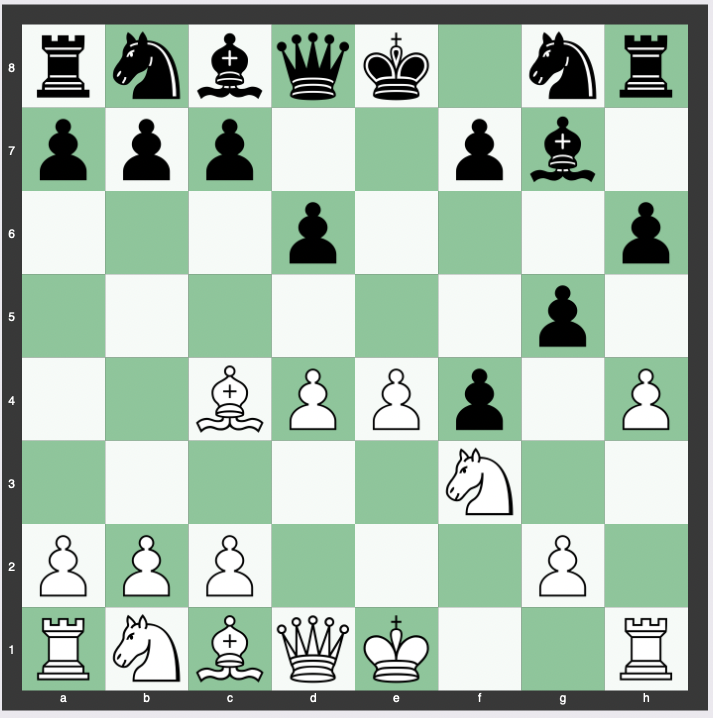The Philidor Gambit is a chess opening that both challenges and rewards adventurous players.
It emanates from the King’s Gambit, a historically popular chess opening that dates back centuries.
The King’s Gambit begins with the moves 1.e4 e5 2.f4, inviting black to seize the initiative by capturing the pawn.
The Philidor Gambit is a sub-variation of this opening and is reached through the following sequence of moves: 1. e4 e5 2. f4 exf4 3. Nf3 g5 4. Bc4 Bg7 5. h4 h6 6. d4 d6.
The Philidor Gambit: A Brief Overview
In the Philidor Gambit, White’s strategy is to maintain central control while navigating the complications that stem from Black’s pawn gambit.
By sacrificing the pawn on f4, White intends to dominate the center with pawns on e4 and d4, while also deploying the knight to f3 and bishop to c4 to maintain pressure on Black’s defenses.
The h4 move is critical to counter Black’s g5 push, with the intention of opening lines against Black’s kingside in the future.
The Move Order in the Philidor Gambit
In short, the move order of the Philidor Gambit is:
1. e4 e5 2. f4 exf4 3. Nf3 g5 4. Bc4 Bg7 5. h4 h6 6. d4 d6

In the Philidor Gambit, the move order is precise and meaningful.
The first two moves 1. e4 e5 2. f4 are standard for the King’s Gambit.
Black captures the pawn with 2…exf4, initiating the gambit.
With 3. Nf3, White develops a piece and attacks the vulnerable pawn at g5, after which Black defends it by playing 3…g5.
With 4. Bc4, White develops another piece, targeting the vulnerable f7 pawn.
The development of the Black’s bishop to g7 with 4…Bg7 is often a precursor to the Philidor Gambit or Hanstein Gambit depending on the continuation.
The Philidor Gambit is 5. h4 h6 6. d4 d6
Counterplay in the Philidor Gambit
White’s response with 5. h4 h6 6. d4 d6 helps to solidify control over the center while simultaneously preparing to disrupt Black’s pawn structure.
Black is often lured into playing h6 to help reinforce the pawn on g5, but this can create weaknesses on the kingside, particularly if White can successfully open the h-file.
The d4 move also prepares to establish a strong pawn center, which can offer a strategic advantage as the game unfolds.
Philidor Gambit vs. Hanstein Gambit
The Hanstein Gambit is another potential continuation after 4…Bg7 and it shares some similarities with the Philidor Gambit.
In both gambits, the move 4…Bg7 is key, but they diverge after this point.
In the Hanstein Gambit, white opts for a safer development with 5.d4 d6 6.0-0 h6, establishing a solid center and kingside safety, whereas in the Philidor Gambit, White seeks more aggressive play with 5.h4 h6 6.d4 d6.
Evaluation of the Philidor Gambit
The Philidor Gambit is generally evaluated at around -0.30 to -0.70 for white.
The best response to the Philidor Gambit is 7. Qd3 or 7. Nc3.
Continuation lines include:
7. Qd3
7. Qd3 Nc6 8. Nc3 Bg4 9. Bb5 Bd7 10. Bxc6 Bxc6 11. Bd2 g4 12. Ng1 Qf6 13. d5 Bd7 14. O-O-O Ne7 15. h5 a6 16. a4 b5 17. Rf1 bxa4 18. Rxf4 Qd4 19. Qxd4 Bxd4 20. Nge2 Be5 21. Rff1 f5 22. exf5
7. Qd3 Nc6 8. Nc3 Bg4 9. Bb5 Bd7 10. Bxc6 Bxc6 11. Bd2 g4 12. Ng1 Qf6 13. d5 Bd7 14. O-O-O Ne7 15. h5 a6 16. a4 b5 17. Rf1 bxa4 18. Nd1 Bb5 19. c4 a3 20. Rxf4 Qd4 21. Qxd4 Bxd4 22. cxb5 a2
7. Nc3
7. Nc3 Bg4 8. Qd3 Nc6 9. Bb5 Bd7 10. Bxc6 Bxc6 11. Bd2 Qf6 12. Nb5 Qe7 13. O-O-O a6 14. Nc3 O-O-O 15. Rhe1 Kb8 16. Kb1 Re8 17. e5 dxe5 18. Nxe5
7. Nc3 Nc6 8. Qd3 g4 9. Ng1 f3 10. Be3 fxg2 11. Rh2 Na5 12. Nge2 Nxc4 13. Qxc4 g1=Q+ 14. Bxg1 Ne7 15. O-O-O d5 16. exd5 O-O 17. Ng3 b5 18. Qb3
Conclusion
The Philidor Gambit is an exciting and tactical variation of the King’s Gambit.
It allows White to seize the initiative early on and fight for control of the center, while also opening the potential for a kingside attack.
This gambit requires precise play and strategic foresight from both sides. Mastering the complexities of this gambit can lead to a dynamic and rich middle game, providing players with a plethora of tactical opportunities.
As with all gambits, understanding the underlying principles, rather than merely memorizing the moves, is key to successfully employing the Philidor Gambit in your games.


